2017 Superbike comparison: CBR1000RR, GSX-R1000R, YZF-R1, ZX-10R
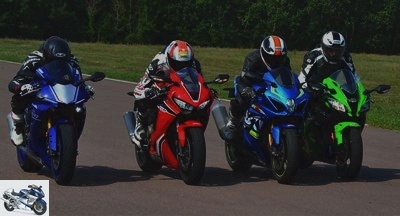
The 2017 vintage of Japanese hypersport motorcycles is exceptional: the sharp Kawasaki ZX-10R and Yamaha R1 are in top form, while the Honda CBR1000RR and Suzuki GSX-R1000 have finally returned to sport and technology.. Site contrasts these four thin 1000 cc blades on the road and on the circuit in an exclusive Superbike comparison on the web !
CBR1000RR, GSX-R1000R, YZF-R1, ZX-10R – Page 3: Circuit test
Much more at ease between two vibrators than between two towns, the ZX-10R displays all its qualities as a world champion on the track: the Green is distinguished first of all by its precise and incredibly stable front axle, the best of the four. on this point. Like riveted to the ground, the Ninja cuts trajectories with a chalk line, whatever the speed or the state of the asphalt. The queen of sharp curved entrances is the ZX-10R !
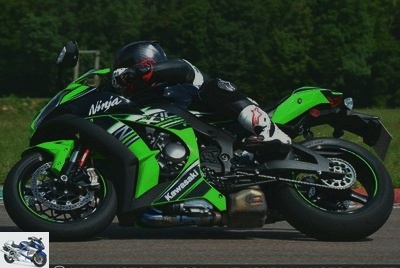
In return, it asks – like – an additional physical implication to be registered on the angle, especially noticeable in the slow sequences. The CBR1000R, YZF-R1, and GSX-R1000R – in that order – tilt more easily and quickly into pins, a quality that gives them superior improvisational ability: overtaking out of the blue or catching up with excess zeal is more evident at their handlebars.
This very reassuring rigor of the Kawasaki makes it possible to take full advantage of its second striking advantage over its rivals: its braking which is at the same time super powerful, constant and perfectly controllable. Here again, Jonathan Rea and Tom Sykes’ bike is a hit, especially as its ABS is thin and responsive enough to never alter its amazing ability to set the brakes..
However, this transparency of ABS is not valid on all motorcycles … The combined system of the Honda (not deactivatable, except by turning a fuse, like its three adversaries) comes into action too quickly when triggering violent braking. Its original S21 tires, more sport-road typed than the RS10s of its compatriots, partly explain this reaction which causes feedback to the lever and possible "misfires" when entering corners..
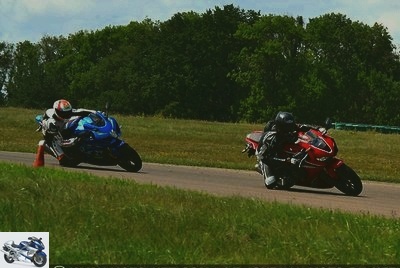
Under the same conditions of brutal decelerations, the CBR1000RR also tends to "wiggle the rump" for lack of totally absorbing the mass transfer. The same phenomenon also affects the R1, quite restless in the rear axle on the very strong brake sockets despite its combined braking from front to rear. The tiny wheelbase (1405 mm!) Of the Red and Blue SBKs, worthy of that of a 600 cc, is undoubtedly no stranger to it..
As for the GSX-R1000R, if its ABS does not pose any particular problem, its braking is however not exempt from criticisms on the circuit despite its attractive Brembo calipers … The Suzuki is the only one to have suffered from endurance problems afterwards. several quick laps, to the point of having finished a "bleeding" session with the right lever practically in contact with the accelerator … Avia hoses would not be superfluous !
In addition, if the softer attack of the pads on its discs is appreciable on the road, the "diehard" trackers will prefer the immediate bite of the Kawasaki, Honda and Yamaha (in that order). Mention very well to the CBR1000RR, second behind the ZX-10R in terms of quality of the braking system. Power, responsiveness and consistency: the Fireblade combines all the desired qualities, despite its less upscale calipers and rubber hoses! Like what…
Horses in shambles, well trained by electronics
Other qualities to credit the Honda on the circuit: its incredible lightness and its very consistent engine breath, despite its small deficit of about 10 horsepower noticeable only when approaching the switch. Very well led by its straightforward and directive front end, the CBR1000RR succeeds in being a formidable weapon in all portions of the circuit, while presenting the perfect balance specific to (good) Honda motorcycles. This famous "Total Control" was very appreciated by all the testers of this comparison, especially our apprentice tracker (see in) !
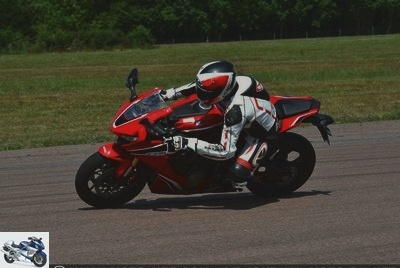
Its only real flaws on the track are its neglected protection that wears down the vertebrae at high speed, its lack of shifter and its electronics more intrusive than that of its rivals. As MNC had noted during his test on the circuit of Portimao (Portugal), the anti-skating of the Honda – which also manages the pitch-ups – seems to indeed come into action a nanosecond after the observation of a drift of the ‘rear or front lifting.
This results in marked losses of adhesion before the electronics regulate the arrival of power, therefore moderately progressive. Sometimes pronounced "commas" of which the Fireblade was the only one to reward us. Its original tire installation certainly influences, again, this fault observed during extreme use. But the "learned fleas" of Tokyo also play a role..
The proof: the Honda is also the only one to go into a fairly pronounced wheeling when the gear is raised full pot in the straight line of the pits, sometimes forcing the driver to slightly give up the throttle to manage manually – and less brutally – these initiation of wheelies. . No need to rely on the rear brake to help: that of our test model was ineffective, while those of the ZX-10R, the R1 and the GSX-R1000R gave satisfaction (for sports cars).
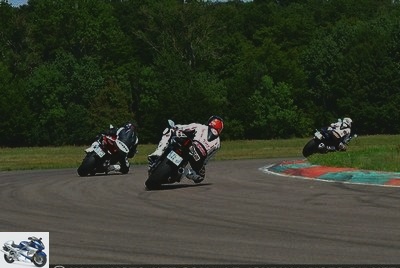
At the handlebars of the three rivals of the CBR, the assistance forms a safety net that stretches upstream of the difficulties: when the Honda gives the feeling of acting in reaction to an excess, the Kawasaki, Suzuki and Yamaha systems deliver the very feeling. clear of having anticipated it. The corrective action that follows is therefore less intrusive, to the benefit of pleasure and efficiency..
Concretely, what does it give to the handlebars? Well, when the power delivered to the rear wheel of the R1, ZX-10R and GSX-R1000R exceeds their grip, the bike goes into a slight drift – very gradual, because in reality totally controlled by the electronics. It suffices to leave the accelerator open to the same degree when a skating or a nose-up begins to really "feel" the moment when the assistance takes over. Exhilarating, especially for non-professional pilots !
The must in this area is the Yamaha system, literally stunning in finesse. To the point of mistaking yourself for Rossi by feeling the rear drift slightly after the point of rope, then the front to maintain itself "electronically" a few tens of centimeters from the ground when the Crossplane delivers its ardor in the straight line which follows. Follow a chip jump – electronic! – Kawasaki and Suzuki devices, also very successful.
Gex dictates its mechanical law … but struggles to use it
Finally, one word – several, in fact! – on the behavior and qualities of motors on the circuit. The GSX-R1000R continues its recital that began on the road thanks to its flexible, powerful 4-cylinder engine offering enormous reach. If the ZX-10R blows it the palm of the explosiveness at high speed (from 10,000 to 14,000 rpm, the Green is an enjoyable fury!), Its cruel absence of trunk serves it in the winding portions.
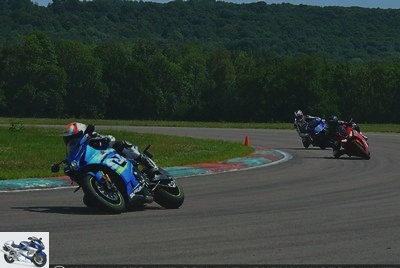
The Kawasaki is the only one to suggest a return to first to get out of the pins, when its three rivals are using their muscles to extricate themselves in second. A character trait already pointed out by MNC during his test of the ZX-10R on the sublime Sepang circuit (Malaysia).
Thanks to its variable valve timing, the GSX-R1000R delivers the best-filled acceleration in this comparison. Its "Variable Valve timing" (VVT), of mechanical type, rests on steel balls which are pressed progressively towards the outside of the gear of the inlet camshaft, in inclined grooves. This has the effect of slowing down its rotation and consequently delays the advance when opening the intake valves..
This new device on a production Superbike – which derives from Hamamatsu’s MotoGP – is completely insensitive to driving, unlike for example the V-Tec of the Honda VFR800. But this Suzuki "VVT" seems damn effective in view of the mechanical performance of the "Gex" 2017. Efficiency and originality: enough to retort, in terms of mechanical originality, to the Crossplane setting of the Yamaha !
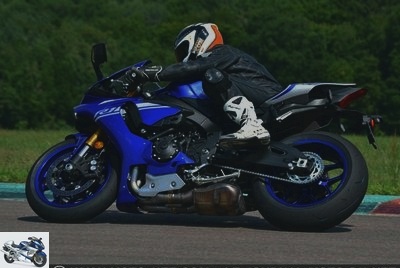
However, if the Suzuki’s 4-cylinder is the most vigorous (helped by its high torque of 117.5 Nm), its incredible power flows in a very predictable way, as on the CBR1000RR. The more explosive ZX-10R impresses more when its cavalry triples! Same remark for the R1, whose less linear revs distill superior sensations..
Finally, the health of the Suzuki unit only moderately affects its rear suspension: in the original configuration, the mono-shock absorber struggles to cope with the continuous surge of power! The comfort appreciated on the road comes with no surprise on the track: the bike lacks downforce when re-accelerating and consequently lets rear axle movements escape..
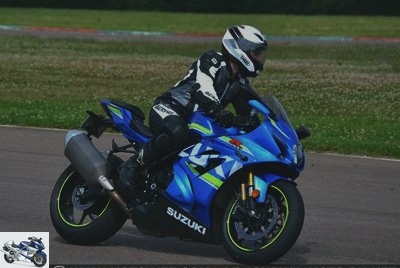
Even to the point of causing the guiding lines in a straight line, failing to properly channel the transfer of masses to the rear generated by its formidable "4-legs"! The suspensions of its three rivals, with openly typed "circuit" rating, are more rigorous in these extreme conditions..
In this little game, the Yamaha shines particularly thanks to its very well calibrated damping and its hyper sporty ergonomics. These two qualities – on the track – combine with its formidable maneuverability to savor each of the sensational revivals of its engine, before plunging headlong into the next bend, leaning on its exceptional front end, the most "informative" of the four. A real racing motorcycle !
- Verdict and rankings of our 2017 Superbike comparison in …
Related articles
-
2017 Superbike comparison: CBR1000RR, GSX-R1000R , YZF-R1 , ZX-10R The 2017 vintage of Japanese hypersport motorcycles is exceptional: the sharp Kawasaki…
-
2017 Superbike comparison: CBR1000RR, GSX-R1000R, YZF-R1, ZX-10R The 2017 vintage of Japanese hypersport motorcycles is exceptional: the sharp Kawasaki…
-
2017 Superbike comparison: CBR1000RR, GSX-R1000R , YZF-R1 , ZX-10R The 2017 vintage of Japanese hypersport motorcycles is exceptional: the sharp Kawasaki…
-
2017 Superbike comparison: CBR1000RR, GSX-R1000R, YZF-R1, ZX-10R The 2017 vintage of Japanese hypersport motorcycles is exceptional: the sharp Kawasaki…
-
2017 Superbike comparison: CBR1000RR, GSX-R1000R, YZF-R1, ZX-10R The 2017 vintage of Japanese hypersport motorcycles is exceptional: the sharp Kawasaki…
-
2017 Superbike comparison: CBR1000RR, GSX-R1000R , YZF-R1 , ZX-10R The 2017 vintage of Japanese hypersport motorcycles is exceptional: the sharp Kawasaki…
-
Comparison test Kawasaki Z900, Suzuki GSX-S750 and Yamaha MT-09: Election of the best Japanese maxi-mid-size roadster In 2017, Kawasaki further…
-
Comparison test Kawasaki Z900, Suzuki GSX-S750 and Yamaha MT-09: Election of the best Japanese maxi-mid-size roadster In 2017, Kawasaki further…
-
Comparison test Multistrada 950 Vs Africa Twin Vs V-Strom 1000: right on target Since its release in January 2016, the Honda Africa Twin has met with a…
-
2017 Suzuki GSX- R1000R review: the beauty of Gex Driven by the most recent hypersport motorcycles for lack of developments in the last ten years or so,…